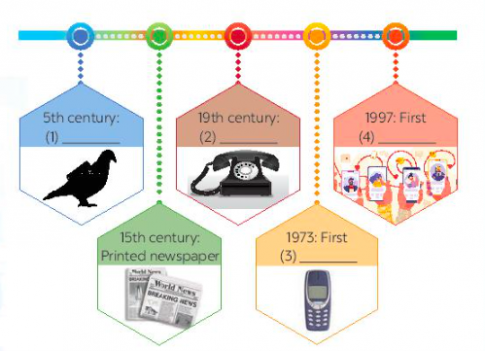4. Work in pairs. Match the ideas (a - h) with parts of an outline (1- 4) for a paragraph about a video call.
(Làm việc theo cặp. Nối các ý (a - h) với các phần của dàn ý (1- 4) cho một đoạn văn về một cuộc gọi video.)
1. What is it?
2. What are its advantages?
3. What are its disadvantages?
4. Will people use it in the future?
a. a phone call using Internet connection
b. needs a high-speed Internet access
c. saves time because people needn't travel to meet
d. transmits live images of the speakers with a webcam or camera on smart devices
e. may spend too much time chatting with each other
f. can be useful for family members and business partners
g. will still be a common tool of communication
h. can see and hear each other in real time
|
1. a |
2. c, d |
3. b, e |
4. f |
1. What is it?
(Đó là gì?)
a. a phone call using Internet connection.
(Cuộc gọi dùng kết nối Internet.)
2. What are its advantages?
(Lợi ích của nó là gì?)
c. saves time because people needn't travel to meet.
(tiết kiệm thời gian vì mọi người không cần đến nơi để gặp.)
d. transmits live images of the speakers with a webcam or camera on smart devices.
(truyền tải hình ảnh trực tiếp của người nói với webcam hay camera trên các thiết bị thông minh.)
h. can see and hear each other in real time
(có thể nhìn thấy và nghe thấy nhau trong thời gian thực)
3. What are its disadvantages?
(Nhược điểm của nó là gì?)
b. needs a high-speed Internet access.
(Cần Internet tốc độ cao.)
e. may spend too much time chatting with each other.
(có thể dành quá nhiều thời gian nói chuyện với người khác.)
4. Will people use it in the future?
(Liệu mọi người có sử dụng nó trong tương lai không?)
f. can be useful for family members and business partners.
(có thể hữu ích cho các thành viên trong gia đình hoặc các đối tác kinh doanh.)

Các bài tập cùng chuyên đề
5. QUIZ. Work in groups.
Complete the diagram of the history of communication technology with the words and phrases from the box.
(Hoàn thành sơ đồ về lịch sử của công nghệ truyền thông với các từ và cụm từ trong hộp.)
carrier pigeon telephone
mobile phone social network

4. Work in pairs. Tell each other whether you agree or disagree with the following ideas.
(Làm việc theo cặp. Nói cho nhau biết bạn đồng ý hay không đồng ý với những ý kiến sau)
1. We should not use our smartphones for more than a few hours every day.
(Chúng ta không nên dùng điện thoại thông minh nhiều hơn vài giờ mỗi ngày.)
2. By 2050, the way people communicate with each other will be different from now.
(Cho đến 2050, cách mà con người giao tiếp với nhau sẽ khác so với hiện tại.)
4. Work in pairs. Choose one means of communication below. Ask and answer questions about it.
(Làm việc theo cặp. Chọn một phương tiện liên lạc dưới đây. Hỏi và trả lời câu hỏi về nó.)
1. Automatic translation function
- When: in 10 years
- Who: social network users
- How: translate comments and private messages in all languages
- Why: remove language barriers
2. Chatbot
- When: in 10 years
- Who: sellers of online shops
- How: instantly reply to customers in all languages
- Why: help sell more products to customers from other countries
5. Report your pair’s conversation to the class by making a similar talk to Mark’s prediction in 3.
(Báo cáo cuộc trò chuyện của cặp bạn với cả lớp bằng cách thực hiện một cuộc nói chuyện tương tự như dự đoán của Mark trong 3.)
1. Work in pairs. List as many ways of communication as you can.
(Làm việc theo cặp. Liệt kê càng nhiều cách giao tiếp càng tốt.)
Example: meeting face to face, sending letters, chatting online, etc.
(Ví dụ: gặp mặt trực tiếp, gửi thư, chat trực tuyến, vân vân.)
2. Describe that means of communication.
(Mô tả phương thức giao tiếp đó)
- What is it?
(Đó là gì?)
- How will it help you communicate?
(Làm cách nào nó giúp mọi người giao tiếp?)
- What advantages might it have?
(Lợi ích có thể có?)
- Will it have any disadvantages? If yes, what are they?
(Nó có nhược điểm nào không? nếu có, chúng là những gì?)
3. Present your idea to the class. You can make a poster or create a model for your presentation.
(Trình bày ý tưởng của bạn trước lớp. Bạn có thể tạo áp phích hoặc tạo mô hình cho bài thuyết trình của mình)
1. Choose the most suitable response A or B to complete each of the following exchanges.
(Chọn câu trả lời A hoặc B phù hợp nhất để hoàn thành mỗi trao đổi sau đây.)
1. A: Ms Mai is an excellent teacher. Her lessons are always interesting. - B: ______
A. I agree with Ms Mai.
B. That's exactly how I feel.
2. A: We'll turn right at the traffic light and … - B: ______
A. Thank you for your help.
B. Hold on. Google map says that we must turn left.
3. A: All groups must submit their school fair plan to me by Thursday so I can … - B: ______
A. Sorry for interrupting, but I think the deadline is Friday.
B. The school fair is a good idea.
4. A: Nick is going to be the new class monitor next semester! - B: ______
A. You're excellent. Congratulations!
B. You're kidding. He'll be in America then.
5. A: Is it hard to cook French food? - B: ______
A. It's not a piece of cake if you are an inexperienced cook.
B. Yes, anyone can do it.
2. Harry and Lam are talking about Harry's brother's problems with writing. Choose A-E to complete their conversation. Then practise it with a friend.
(Harry và Lâm đang nói về vấn đề viết lách của anh trai Harry. Chọn A-E để hoàn thành cuộc trò chuyện của họ. Sau đó thực hành nó với một người bạn.)

Harry: My brother's writing is terrible.
Lam: Really? (1) ___________
Harry: First, his handwriting is really bad, but he always says that there's no need to improve it.
Lam: Maybe it isn't a problem. (2) ________________
Harry: But he's only in grade six now, and he still has to write by hand a lot.
Lam: That's exactly how I felt. (3) ______________
Harry: And he writes very short sentences. Sometimes his essays sound like a conversation.
Lam: (4) _____________
Harry: Yeah. I know that learning writing is not a piece of cake but
Lam: Hold on. (5) __________. How about asking him to try it?
Harry: Sounds good. I'll ask him.
3. Make a similar conversation. Use the information given below or your own ideas.
(Thực hiện một cuộc trò chuyện tương tự. Sử dụng thông tin được cung cấp dưới đây hoặc ý tưởng của riêng bạn.)
Topic: Problems with speaking French
(Chủ đề: Các vấn đề khi nói tiếng Pháp)
Problem 1: Lack vocabulary - Don't want to learn new words using traditional ways
(Vấn đề 1: Thiếu từ vựng - Không muốn học từ mới theo cách truyền thống)
Solution 1: Use online flashcards and vocabulary learning apps
(Giải pháp 1: Sử dụng thẻ flash trực tuyến và ứng dụng học từ vựng)
Problem 2: Have no one to practise speaking French with
(Vấn đề 2: Không có ai luyện nói tiếng Pháp cùng)
Solution 2: Join a French learning forum on the Internet and find a speaking partner
(Giải pháp 2: Tham gia một diễn đàn học tiếng Pháp trên Internet và tìm một đối tác nói)






